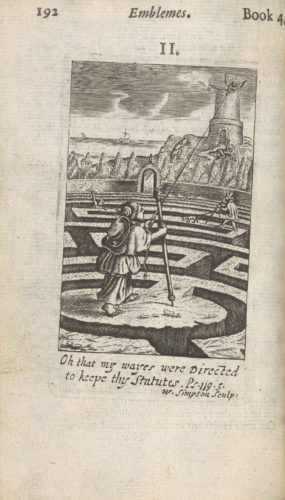Elaborate knot gardens, labyrinths and mazes were immensely popular features of garden in the early modern period, simultaneously offering aesthetic pleasure, social entertainment, and spiritual instruction. While labyrinths were unicursal, and mazes multicursal – offering a choice between alternative paths – the terms were often used interchangeably. As in Francis Quarles’s emblem, mazes could represent the challenges of knowing the right moral path through life. Indeed, many medieval churches contained a labyrinth that offered a allowed the pilgrim to trace the path that would lead to God, through a physically mapped metaphor. But the positive symbolism could slip into its opposite, because a rigorous path to truth, knowledge or God involved errors, digressions and sometimes loss of direction. Furthermore, labyrinths were also intricate and artful structures which could embody an aesthetic temptation: while Quarles’s pilgrim is drawn straight by a string let down by an angel, the viewer’s eyes are invited to dwell on the elaborate maze in the foreground, with the human figures and the dog and the ingenious design. Quarles’s emblem figures the dynamic between the straight path and the winding ways that labyrinthine routes to knowledge entail, and the tensions between the different associations of the labyrinth.
© 2019 University of Cambridge and Fitzwilliam Museum











